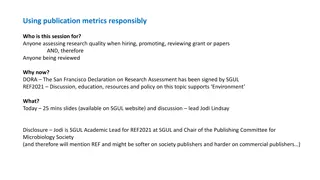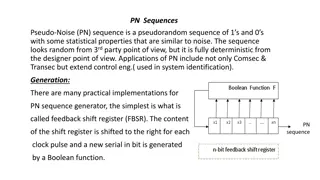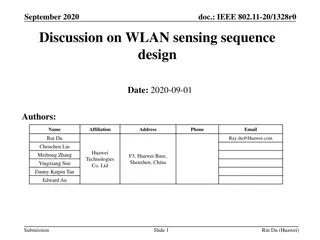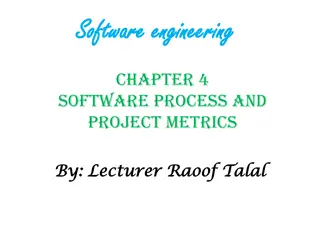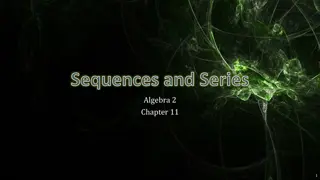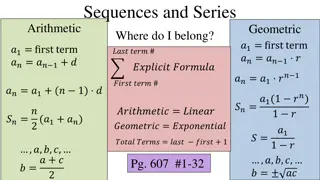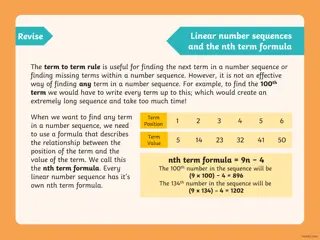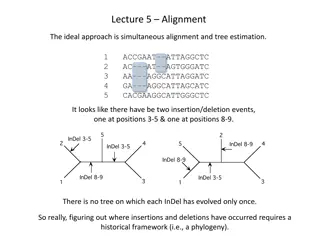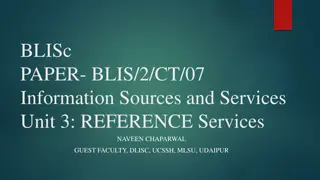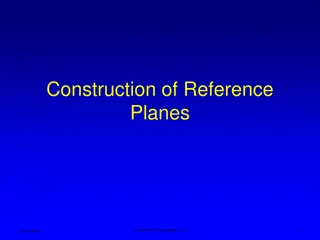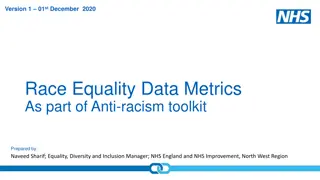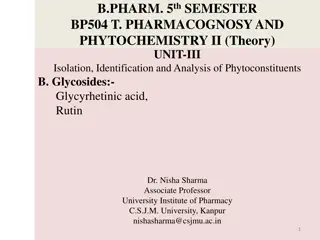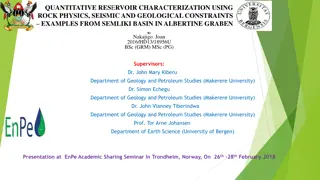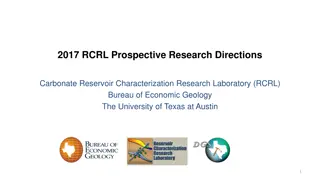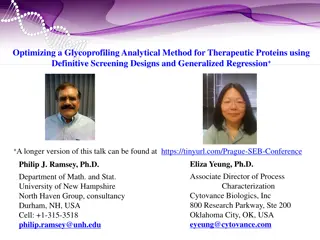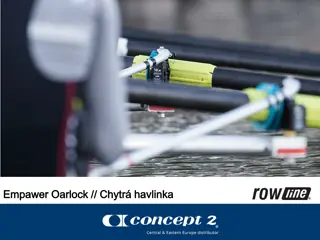5G Video Characterization: Reference Sequences and Metrics
Scenarios and anchor generation for various video codecs used in 5G services are detailed, along with reference sequences for different applications like Full HD streaming, 4K-TV, screen content, and more. Tools and repositories for accessing reference sequences are provided, and metrics for evaluating video quality in terms of bitrate, peak signal-to-noise ratio, and more are outlined.
Download Presentation

Please find below an Image/Link to download the presentation.
The content on the website is provided AS IS for your information and personal use only. It may not be sold, licensed, or shared on other websites without obtaining consent from the author. Download presentation by click this link. If you encounter any issues during the download, it is possible that the publisher has removed the file from their server.
E N D
Presentation Transcript
3GPP 5G Video Characterization TR 26.955 approved at SA#96 (June 2022) Feasibility Study in Rel-17
Scenarios are defined to identify how video codecs are typically used in 5G type of services To define reference sequences (types and formats), decoding & encoding constraints Defined Scenarios Scenario 1: Full HD Streaming Scenario 2: 4K-TV Scenario 3: Screen Content Scenario Scenario 4: Messaging and Social Sharing Scenario 5: Online Gaming Note: 8K scenario discussed, but not added Scenarios
Anchor Generation for each Scenario Anchor Configuration Reference Software Conforming Anchor Bitstream Anchor Sequence Reference Sequence Decoder Encoder Metrics Computation Anchor Metrics
Tools and Repositories https://dash-large- files.akamaized.net/WAVE/3GPP/5GVideo/ReferenceSequences/ https://dash-large- files.akamaized.net/WAVE/3GPP/5GVideo/Bitstreams/ https://github.com/haudiobe/5GVideo/
Reference Sequences: Example 4K-TV Key S2-R1 S2-R2 S2-R3 S2-R4 S2-R5 S2-R6 S2-R7 S2-R8 Name Brest-Sedof Rain Fruits Park Joy Soccer Tunnel Flag Boat Fountain Riverbank Reference Annex C.3.1.3.1 Annex C.3.1.3.2 Annex C.3.1.3.3 Annex C.3.1.3.4 Annex C.3.1.3.5 Annex C.3.1.3.6 Annex C.3.1.3.7 Annex C.3.1.3.8 Resolution 3840 x 2160 3840 x 2160 3840 x 2160 3840 x 2160 4096 x 2160 4096 x 2160 4096 x 2160 3840 x 2160 Frame rate 60 50 50 23.98 59.94 59.94 59.94 50 Colour Gamut BT.709 BT.709 BT.709 BT.709 BT.709 BT.709 BT.709 BT.709 Number of Frames 300 500 500 385 600 300 600 600 Scene Cut 0 0 0 4 0 0 0 0 Key Name Reference Resolution Frame rate Colour Gamut Number of Frames Scene Cut S2-R11 Life-Untouched Annex C.3.2.3.1 4096 x 2160 59.94 BT.2020 450 0 S2-R12 Meridian Annex C.3.2.3.2 3840 x 2160 59.94 BT.2020 0 327 S2-R13 Sol-Levante Annex C.3.2.3.3 3840 x 2160 24 BT.2020 0 145 S2-R14 Cosmos Annex C.3.2.3.4 3840 x 2160 24 BT.2020 0 182 432 S2-R15 Elevator Annex C.3.2.3.5 4096 x 2160 59.94 BT.2020 0 S2-R16 Sparks Annex C.3.2.3.6 4096 x 2160 59.94 BT.2020 261 0 S2-R17 Nocturne Annex C.3.2.3.7 3840 x 2160 BT.2020 0 60 370 All sequences are available here https://dash-large-files.akamaized.net/WAVE/3GPP/5GVideo/ReferenceSequences/ Example annotation https://dash-large-files.akamaized.net/WAVE/3GPP/5GVideo/ReferenceSequences/Brest-Sedof/Brest-Sedof.json
Metrics SDR & HDR Name parameter bitrate Type BIGINT DOUBLEPRECISION Semantics the associated variation parameter as defined for the anchor, for example the QP The size of the file divided by the duration of the reference sequence in bit/s as defined in clause 5.5.1 with 2 decimal digits accuracy. Peak signal to noise ratio for Y planes in dB as defined in clause 5.5.2 with 2 decimal digits accuracy. y_psnr u_psnr v_psnr ms_ssim vmaf bitrate_log encode_time decode_time DOUBLEPRECISION DOUBLEPRECISION DOUBLEPRECISION DOUBLEPRECISION DOUBLEPRECISION DOUBLEPRECISION DOUBLEPRECISION DOUBLEPRECISION Peak signal to noise ratio for U planes in dB as defined in clause 5.5.2 with 2 decimal digits accuracy. Peak signal to noise ratio for V planes in dB as defined in clause 5.5.2 with 2 decimal digits accuracy. structural similarity between frames as defined in clause 5.5.2 with 4 decimal digits accuracy. Video Multimethod Assessment Fusion (VMAF) as defined in clause 5.5.2 with 2 decimal digits accuracy. The bitrate as documented by the encoder log. If not known, it is set to 0. Total time spent to encode the sequence with reference encoder in seconds. If not known, it is set to 0. Total time spent to decode the sequence with reference decoder in seconds. If not known, it is set to 0. Name Parameter Bitrate y_psnr u_psnr v_psnr Wpsnr psnrl100 de100 bitrate_log encode_time Type BIGINT DOUBLEPRECISION DOUBLEPRECISION DOUBLEPRECISION DOUBLEPRECISION DOUBLEPRECISION DOUBLEPRECISION DOUBLEPRECISION DOUBLEPRECISION DOUBLEPRECISION Semantics the associated variation parameter as defined for the anchor, for example the QP The size of the file divided by the duration of the reference sequence in bit/s as defined in clause 5.5.1. Peak signal to noise ratio for Y planes in dB as defined in clause 5.5.2. Peak signal to noise ratio for U planes in dB as defined in clause 5.5.2. Peak signal to noise ratio for V planes in dB as defined in clause 5.5.2. Weighted peak signal to noise ratio for Y, U and V planes in dB as defined in clause 5.5.3. PSNRL100 as defined in clause 5.5.3 DE100 as defined in clause 5.5.3. The bitrate as documented by the encoder log. If not known, it is set to 0. Total time spent to encode the sequence with reference encoder in seconds. If not known, it is set to 0.
Verification Anchor bitstream verification: Anchor bitstreams are correct. By using a defined reference sequence, an anchor configuration as well as a reference encoder, two different executions of this process results in the same anchor bitstream. Anchor reconstruction is correct. By using a verified anchor bitstream, a reference decoder in two different implementations results in the same anchor sequence, in the same quality metrics.
Characterization Characterization is the comparison of a codec under test with an anchor based on the framework introduced in this clause. Characterization in this report is based on Bj ntegard-Delta (BD)-rate. A full characterization of a codec for a scenario against a 3GPP codec shall provide at least the following metrics The BD-rate gain for each defined anchor tuple and each required metric The average BD-rate gain across all anchors of the scenario for each required metric.
Max value max_range Interpolation Anchor Interpolation Test min_range BD-Rate gain Min value Overlap Bitrate to log scale Interpolated Points Quality Metric
HEVC against H.264/AVC Average BD Rate Gains using PSNR Scenario S1 FullHD S3 Screen no RA S3 Screen RA S4 Sharing no RA S4 Sharing RA S5 Gaming no RA S5 Gaming RA Minimum Maximum HEVC 41.5 52.4 44.2 46.7 36.2 41.1 31.0 31.0 52.4
New Codecs against H.265/HEVC Average BD Rate Gains using PSNR Scenario S1 FullHD S1 FullHD HDR S2 4K S2 4K HDR S3 Screen no RA S3 Screen RA S4 Sharing no RA S4 Sharing RA S5 Gaming no RA S5 Gaming RA Minimum Maximum AV1 19.1 14.8 18.2 16.8 35.5 32.6 8.9 16.9 21.6 21.4 8.9 35.5 EVC 18.1 21.1 20.4 23.2 23.4 22.4 20.6 18.2 17.6 16.0 16.0 23.4 VVC 35.8 39.5 36.7 38.4 55.9 54.5 28.5 24.8 33.2 30.9 24.8 55.9
One important outcome of the work documented in this Technical Report is the characterization and evaluation of H.265/HEVC against relevant scenarios and its characterization against H.264/AVC. Also, a first understanding of H.265/HEVC performances versus new codecs was developed. From the scenarios and results in this Technical Report it is observed that: H.265/HEVC does not show any functional deficiencies or gaps, nor does it lack any relevant features. In terms of compression efficiency, H.265/HEVC, evaluated based on the HM, performs sufficiently well for all the scenarios in this technical report. Providing consistent HEVC-based interoperability in 3GPP services, for traditional and new scenarios, is definitely beneficial. It is recommended that 3GPP consider upgrading specifications to support profiles, levels, and possibly features available in HEVC. Features may include better support for screen content and computer-generated content, XR/AR type of services, as well as low and very low latency services. Summary HEVC
The framework and the initial results for new codecs demonstrate coding performance improvements over H.265/HEVC for some codecs of up to 50%. However, the initial results are not considered mature enough to support concrete recommendations on adding new codecs. The potential addition of any new codec in 3GPP services and specifications requires diligent preparation, including the identification of needs and requirements for different scenarios, as well as a complete characterization against existing codecs. Summary New Codecs The information in this TR, as well as any new developments in 3GPP with respect to codecs in latest specifications, could serve as a baseline for future work. Such an effort may lead to conclusions on the potential addition of any new codec in 3GPP services and specifications. However, no immediate need has been identified to initiate such follow-up work.
Timeline Considerations HEVC Work Item? New codecs preparation





